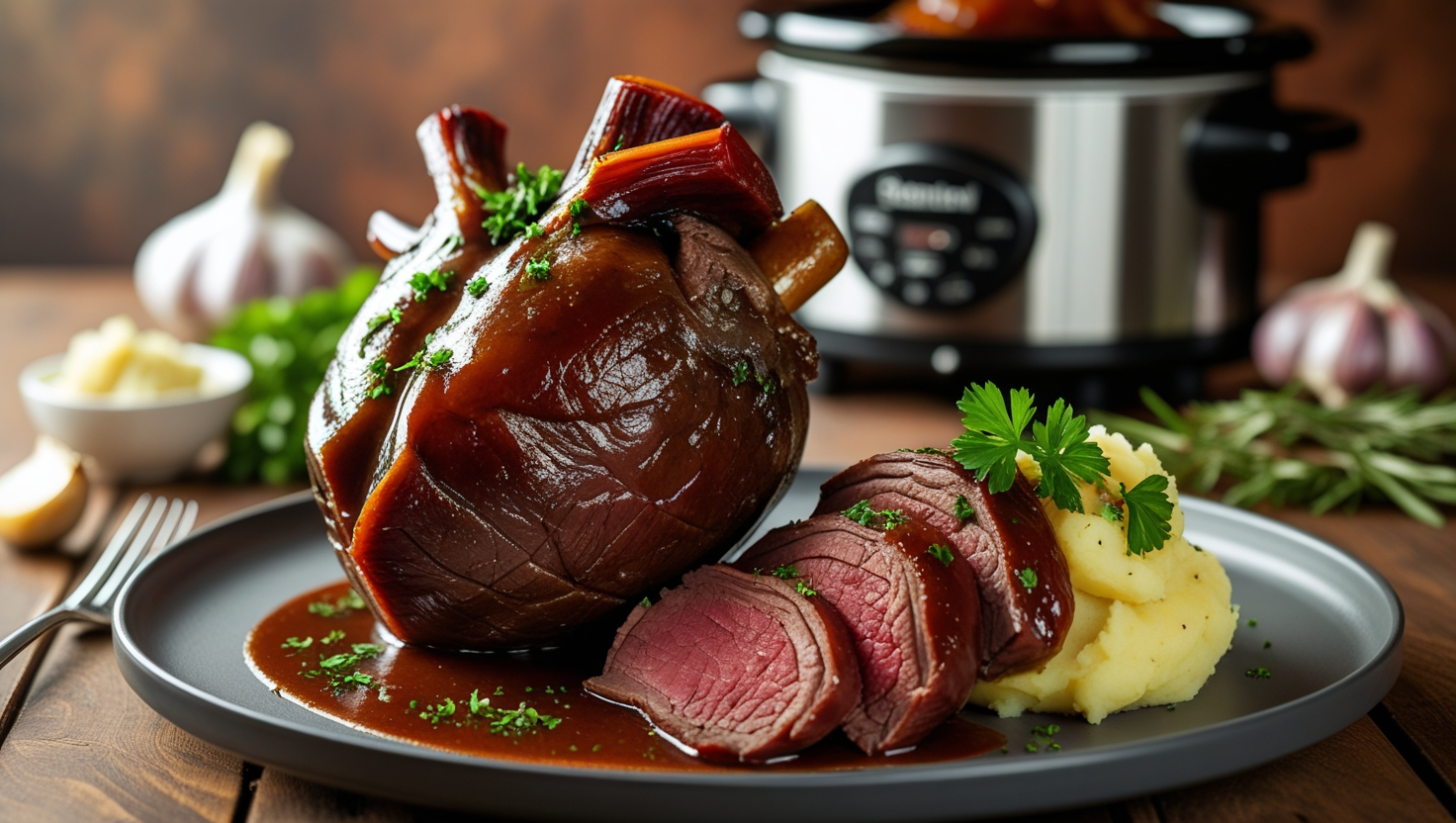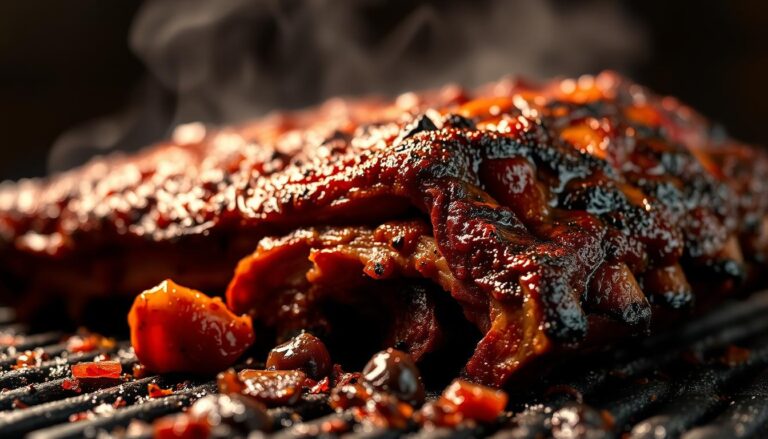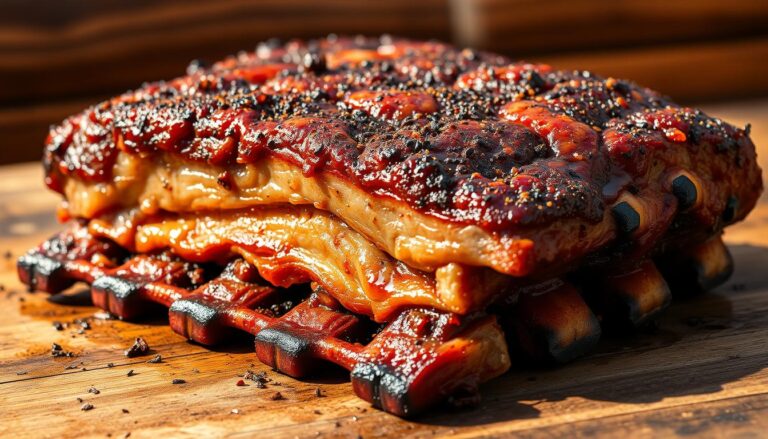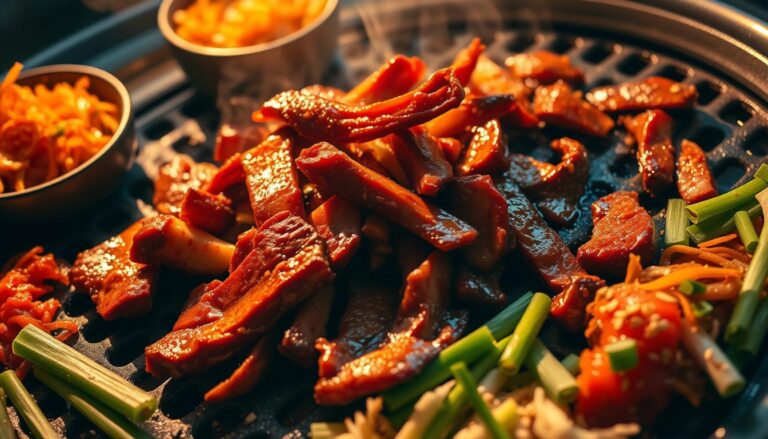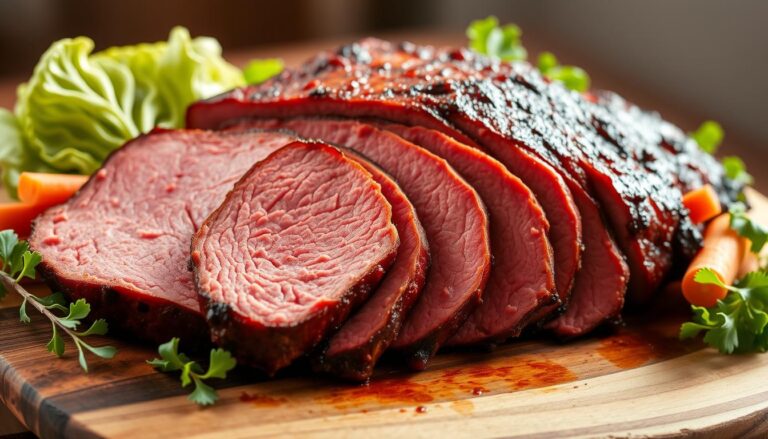When you see a slab of beef heart at the butcher, you might pause. It looks different from regular meat. But, it’s packed with nutrients and can make delicious meals. Whether you’re new to cooking or exploring new foods, learning to cook beef heart is exciting.
This guide will help you every step of the way. It turns uncertainty into confidence. You’ll soon be cooking up a storm with beef heart.

Table of Contents
Understanding Beef Heart: Nutrition and Benefits
Before we dive into recipes, let’s see why beef heart is great for you. It’s packed with beef heart nutritional benefits. These benefits include a lot of vitamins and minerals, more than regular meat.
Nutritional Profile of Beef Heart
Beef heart is very nutritious. A 3-ounce serving gives you:
- 22g of protein
- 4mg zinc (27% DV)
- 15mcg selenium (22% DV)
- 11mg iron (61% DV)
- Over 100% DV of B12 and B3
Health Benefits of Including Beef Heart in Your Diet
The nutrients in beef heart help a lot. They boost energy, help muscles grow, and keep you healthy. Iron helps carry oxygen, and B vitamins turn food into energy. Selenium fights off cell damage.
For athletes or anyone looking for healthy food, beef heart nutritional benefits are great. They give lasting energy without added sugars or processed stuff.
Comparing Beef Heart to Other Organ Meats
Beef heart tastes mild, like steak. It’s great for trying organ meats for the first time. While liver has more vitamin A, beef heart has a balanced mix of nutrients.
- Less metallic taste than liver
- Softer texture than tripe
- Higher protein than sweetbreads
Its mild taste and soft texture make it a great starting point for trying different organ meats.
Selecting the Perfect Beef Heart at the Butcher or Market
When you start how to prepare beef heart, picking the right cut is crucial. Look for a deep red color without any grayish tones. The texture should be firm but not slimy, and it should smell fresh.
Avoid any sour or ammonia-like smells. These can be signs of spoilage.
- Specialty butchers
- Asian or Latin grocery stores
- Farmers’ markets (local ranchers)
- Online retailers like US Wellness Meats
| Factor | Grass-Fed | Conventional |
|---|---|---|
| Nutrition | Higher omega-3s, lower fat | More marbling, affordable |
| Taste | Milder flavor | Stronger gamey notes |
| Cost | 15-25% pricier | More budget-friendly |
Ask butchers if they offer trimmed or sliced portions. This can save you time. A whole heart weighs 2-3 pounds and serves 4-6 people.
Keep it in the coldest part of your fridge for 1-2 days. Or, freeze it wrapped airtight for up to 3 months. Always check for USDA inspection stamps to ensure it’s safe.
Essential Tools and Equipment for Preparing Beef Heart
Learning how to prepare beef heart begins with the right tools. Here are the must-haves for every step.
Knives and Cutting Tools
A sharp beef heart cooking tips start with the right blades. You’ll need:
- Boning knife: Trim sinew and fat with a flexible 8-inch blade.
- Kitchen shears: Cut through gristle or thick membranes effortlessly.
- Chef’s knife: Slice portions evenly after initial prep.
Preparation Surfaces and Containers
Use non-porous plastic cutting boards to avoid cross-contamination. Airtight containers like Tupperware are great for marinating. Always wash surfaces thoroughly after handling raw organ meats.
Cooking Equipment Recommendations
| Equipment | Use | Alternative |
|---|---|---|
| Cast iron skillet | Searing for even browning | Stainless steel pan |
| Slow cooker | Braising to tenderize meat | Large stockpot with lid |
| Sous vide machine | Precision temperature control | Immersion circulator setup |
No sous vide? Slow cookers work just as well. Always clean tools thoroughly after use.
How to Prepare Beef Heart Step-by-Step
Learning how to prepare beef heart begins with careful handling. Follow these steps to ensure your meat is clean, trimmed, and ready for cooking:
Cleaning and Rinsing Techniques
Rinse the heart under cold running water. Use your fingers or a soft brush to scrub crevices, removing any residue. A quick vinegar soak (10 minutes) helps eliminate odors. Pat dry with paper towels before proceeding.
Trimming Fat and Removing Unwanted Tissues
- Identify thick fat layers and silver skin—trim them with a sharp knife.
- Cut out valve sections and arteries; discard these parts.
- Remove gristle clusters near the base where the aorta attached.
Pro tip: Keep heart muscle fibers intact to preserve texture during cooking beef heart.
Cutting Methods for Different Cooking Applications
- Slicing for grilling: Cut against the grain into ½-inch thick slices. Marinade 2+ hours before cooking.
- Cubes for stews: Dice into 1-inch pieces. Simmer in broth for 2-3 hours until tender.
- Roasting: Leave as a whole muscle. Score the surface with a knife before roasting at 325°F for 2-3 hours.
Important: Always store unused portions in an airtight container within 2 hours of preparation.
Creating the Perfect Beef Heart Marinade
Marinating beef heart is key to unlocking its potential. A well-balanced beef heart marinade infuses flavor while tenderizing the meat’s dense texture. Acids like vinegar, citrus juice, or yogurt break down muscle fibers. This ensures your flavorful beef heart stays juicy and tender.
- Citrus-Herb Marinade: Combine orange juice, garlic, olive oil, rosemary, and thyme. Marinate 6–8 hours for grilling.
- Soy-Ginger Marinade: Mix soy sauce, fresh ginger, brown sugar, and rice vinegar. Use 4–6 hours for stir-fries or skewers.
- Red Wine Marinade: Blend red wine, garlic, bay leaves, and peppercorns. Marinate 12–24 hours for slow-cooked dishes.
Score the meat lightly before submerging it fully in the marinade. Vacuum-sealing or agitating the mixture boosts absorption. Marinate in the fridge to prevent bacterial growth. Always boil leftover marinade before using it as a sauce.
Experiment with spices like smoked paprika or cumin for extra depth. Let the meat rest in the fridge for at least 6 hours—longer for thicker cuts. Proper marinating transforms beef heart into a tender, versatile ingredient ready for any cooking method.
Tenderizing Techniques for Beef Heart
Learning to cook tender beef heart is all about breaking down tough fibers. We’ll look at beef heart cooking tips to get a tender texture that’s not too soft.
Mechanical Tenderizing Methods
Begin by physically breaking down the meat. Use a meat mallet to pound the heart, especially on thicker parts. You can also skewer it or score the surface with a knife. These steps help soften the meat by breaking down connective tissues.
Acidic Marinades for Tenderizing
Acids like lemon juice, vinegar, buttermilk, or yogurt can tenderize the meat in 2–4 hours. But don’t marinate it too long, or it might get tough. Mix acids with olive oil and spices for flavor and tenderness.
Slow Cooking for Maximum Tenderness
Choose low-and-slow cooking methods:
- Braising: Simmer in a covered pot with broth at 300°F (150°C) for 2–3 hours.
- Sous Vide: Cook at 135°F (57°C) for 8–12 hours for even results.
- Pressure Cooking: Use the meat/stew setting for 50–60 minutes.
Focus on tenderizing the ventricles, which are denser. Aim for a balance to keep some firmness. Trying these methods will help you get the most out of tender beef heart.
Popular Cooking Methods for Flavorful Beef Heart
Learning the right cooking method is crucial for a flavorful beef heart experience. Here are some techniques to try for the perfect balance of texture and taste:
- Grilling: Preheat a grill to medium-high. Brush the meat with oil, sear for 6-8 minutes per side. Aim for a caramelized crust and smoky undertones. Rest briefly before slicing.
- Pan-searing: Use a cast-iron skillet. Cook in batches over high heat for 4-5 minutes per side. Achieve a golden crust while keeping the interior medium-rare to medium for tenderness.
- Stir-frying: Slice thinly and toss in a wok with aromatics. High heat for 2-3 minutes ensures quick sear without overcooking.
- Braising: Simmer in a Dutch oven with broth and herbs for 2-3 hours. This tenderizes tougher cuts, yielding fork-tender results.
- Slow roasting: Cook at 275°F for 4 hours. Low-and-slow develops deep flavors without drying the meat.
- Sous vide: Seal and cook at 130°F for 4-6 hours. Perfect for even doneness; finish with a quick sear for texture contrast.
When cooking beef heart, avoid low heat for searing. Cold pans can make the meat gray and mushy. Always let the meat rest for 5-10 minutes after cooking to keep the juices in. Overcooking can make the meat chewy, so use a meat thermometer for the right doneness (125°F-130°F).
“The best flavorful beef heart comes from balancing high heat for crust with precise timing,” says chef Maria Alvarez. “Never rush the rest—patience is key.”
Try pairing cooking methods with acidic marinades or bold spices to boost the natural umami. Experiment to find your favorite way to enjoy this nutrient-rich cut.
Regional and International Beef Heart Recipes
Global cuisines offer creative ways to cook this versatile cut. Explore these beef heart recipe ideas inspired by traditional cooking techniques:
American Classics Using Beef Heart
Bring hearty flavors to your kitchen with these dishes:
- Grilled Beef Heart with Chimichurri: Marinate slices in olive oil, garlic, and oregano before grilling. Top with fresh herb sauce.
- Heart and Kidney Pie: Layer heart with vegetables in a savory pie crust for a rustic meal.
- Beef Heart Chili: Simmer heart with beans, tomatoes, and spices for a slow-cooked stew.
- Heart Burger Patties: Finely chop heart and form into patties for a protein-packed twist.
Latin American Anticuchos and Other Specialties
Discover vibrant flavors from the Americas:
- Peruvian Anticuchos: Skewer marinated heart chunks and grill over charcoal. A street food classic.
- Brazilian Coração Assado: Rub with salt, garlic, and orange zest before roasting.
- Mexican Tacos de Corazón: Slice grilled heart thinly and serve with salsa, onion, and lime.
European Approaches to Cooking Beef Heart
Old-world techniques shine in these dishes:
- Italian Cuore alla Toscana: Braise with red wine, rosemary, and carrots for tenderness.
- French Cœur en Daube: Slow-cook heart in red wine and mirepoix for 3 hours.
- British Deviled Heart: Stuff with breadcrumbs, mustard, and thyme before baking.
These recipes prove cooking beef heart is both a culinary adventure and a nod to tradition. Adapt these methods to your taste preferences while honoring their heritage. From skewers to stews, each technique highlights the heart’s ability to absorb bold flavors.
Troubleshooting Common Beef Heart Preparation Challenges
Mastering beef heart means knowing how to fix common problems. Here’s how to avoid mistakes and get perfect results every time.

- Tough texture? Start by trimming off excess fat and connective tissue. Then, marinate it for 12+ hours using acidic ingredients like vinegar or citrus. Slow cooking, like braising or slow roasting, makes the beef heart tender.
- Strong gamey flavor? Soak the meat in milk overnight to reduce odors. Use bold spices or soy sauce in marinades to balance the taste.
- Dryness? Never overcook the beef heart. Use a meat thermometer to check for 145°F (63°C). Moisture-rich methods like stewing keep it juicy.
- Uncertain doneness? Check the internal temperature often. Look for fibers that separate easily when pierced with a fork.
Food safety is crucial. Always store raw heart below 40°F (4°C) and cook to safe temperatures. For those who are hesitant, slice it thinly and serve with familiar flavors like barbecue sauce or chimichurri.
“The key to tender beef heart is patience—proper prep and timing make all the difference.”
Follow these beef heart cooking tips to turn potential pitfalls into perfect results. With practice, you’ll impress even the most skeptical palate.
Conclusion: Embracing Beef Heart as a Nutritious and Delicious Ingredient
Beef heart is a great protein choice because it’s full of iron, B vitamins, and protein. It’s also easy to cook and affordable. You can grill, braise, or marinate it for many tasty dishes.
Start with simple cooking methods like slow cooking or acidic marinades. This will help you get used to cooking with beef heart. Try out different recipes from around the world to see how versatile it is.
Begin with a simple recipe like simmered heart with herbs or citrus-marinated skewers. Then, you can try more complex dishes. Share your cooking adventures online or with friends. This way, you’ll join a community that values whole-animal cooking.
FAQ
What is beef heart, and how can I prepare it?
Beef heart is a meat packed with nutrients like protein and vitamins. To prepare it, you need to clean, trim, and cook it right. Our guide will show you how to do it all.
What are some tasty beef heart recipes I can try?
Beef heart can be cooked in many tasty ways. Try grilling it with chimichurri, slow-cooking it in chili, or making Peruvian anticuchos. Each recipe uses special marinades and cooking methods to bring out the flavor.
How do I make a great beef heart marinade?
A good marinade for beef heart has vinegar or citrus, herbs, and spices. Marinate it for 2-24 hours to make it tender and flavorful. Scoring the meat before marinating helps the flavors soak in better.
What cooking methods work best for beef heart?
You can grill, pan-sear, braise, or sous vide beef heart. Each method gives a different taste and texture. Choose the one that fits your taste and the meat’s cut.
What should I look for when selecting beef heart at the market?
Look for a deep red color, a fresh smell, and a firm texture when buying beef heart. Grass-fed options are often better for you than conventional ones.
How can I ensure my beef heart turns out tender?
For tender beef heart, trim it well, marinate it, and slow cook it. You can also tenderize it mechanically. This makes the meat soft and easy to chew.
What are some nutritional benefits of consuming beef heart?
Beef heart is full of protein, iron, zinc, and B vitamins, especially B12. These nutrients help build muscles, increase energy, and support health. It’s a superfood for many diets.
How can I address common cooking challenges with beef heart?
If beef heart is tough or dry, adjust how you trim and marinate it. Use a meat thermometer to avoid overcooking. Proper handling and cooking solve most problems with beef heart.

